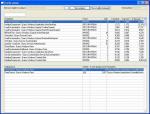performance
Table Block Mapping For Type I Areas
Sun, 2015-08-02 21:30 — TheMadDBAMany people know of the perils of record scatter and fragmentation with Type I areas. This tool provides an easy way to determine how scattered your data is and present that information in an easy to view HTML format. Primarily I use this tool to explain to non technical clients and managers why we need to migrate data from Type I to Type II areas.
You specify which tables are to be mapped by passing which areas or tables to the tool. CAN-DO style lists are supported in order to easily exclude larger tables from the list.
OpenEdge Database Advisor
Sun, 2015-08-02 21:19 — TheMadDBAThe OpenEdge Database Advisor is intended to provide a quick checkup for common database configuration issues. Obviously proper tuning for an application requires much more than any tool can provide, but the advisor should highlight some of the most common low hanging fruit.
For best results you will need a recent database analysis file (proutil -C dbanalys) and you should run this against your production database. A large portion of the suggestions will be based on VST information that will differ greatly between your production and test environments.
OpenEdge Session Tracing
Sun, 2015-08-02 21:06 — TheMadDBATuning OpenEdge application code can be daunting for a beginner. Although the tools required to debug and tune your code are available in the 4GL, they are not always easy to use and understand. This toolset aims to simplify the process of tuning without requiring major (or any) changes to your code.
Application performance profile viewer
Fri, 2010-01-15 16:16 — StefanThis profiler identifies performancebottlenecks in your application by analysing the logfile you create with the log-manager.  Profiler
Profiler
4GLTrace LOG-MANAGER Reporter
Tue, 2007-03-13 14:14 — timk519Reads output from a LOG-MANAGER:LOG-ENTRY-TYPE = "4GLTRACE:4" and reports the line number, date, time, statement elapsed time, total elapsed time, nesting level, action, action adjective, and remaining data in a columnar format
Code Standards - developing a manual
Mon, 2007-02-26 16:46 — schlatterI am working on a manual of code standards for my division, and would appreciate input about this. I've incorporated (or adapted) many of the entries from the prolint lists of bugs, style improvement, performance enhancements, etc. Of course this will be a combination of helpful advice, common sense, ways to make the code more readable and re-usable, and ways to prevent problems down the line.
I will appreciate any suggestions or ideas that are sent in.
